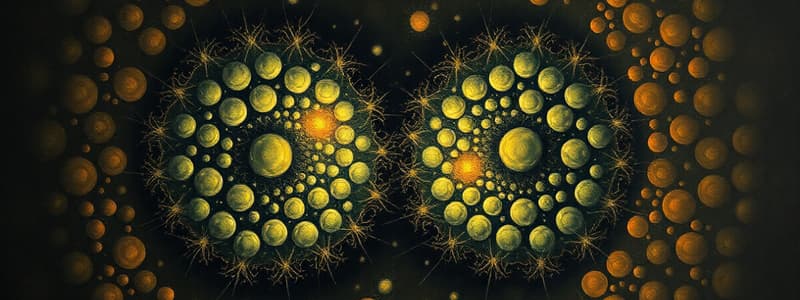Podcast
Questions and Answers
What process do prokaryotes, such as bacteria and archaea, primarily use for reproduction?
What process do prokaryotes, such as bacteria and archaea, primarily use for reproduction?
- Meiosis
- Mitosis
- Budding
- Binary fission (correct)
In binary fission, what action occurs to the chromosomes before the cell divides?
In binary fission, what action occurs to the chromosomes before the cell divides?
- Chromosomes migrate to opposite poles
- Chromosomes condense into chromatin
- Chromosomes replicate at the origin of replication (correct)
- Chromosomes undergo crossing over
What happens to the plasma membrane during binary fission?
What happens to the plasma membrane during binary fission?
- It pinches inward, dividing the cell into two (correct)
- It expands outward to accommodate growth
- It remains unchanged during the process
- It forms a new cell wall between the two daughter cells
Which of the following statements is correct regarding the evolutionary relationship between binary fission and mitosis?
Which of the following statements is correct regarding the evolutionary relationship between binary fission and mitosis?
What type of cell division is observed in certain protists that shows characteristics of both binary fission and mitosis?
What type of cell division is observed in certain protists that shows characteristics of both binary fission and mitosis?
Flashcards
Binary Fission
Binary Fission
A type of asexual reproduction in prokaryotes where a single cell divides into two identical daughter cells.
Prokaryotes
Prokaryotes
Single-celled organisms lacking a nucleus and membrane-bound organelles (bacteria and archaea).
Chromosome Replication
Chromosome Replication
The process of copying a cell's genetic material before cell division.
Origin of Replication
Origin of Replication
Signup and view all the flashcards
Daughter Chromosomes
Daughter Chromosomes
Signup and view all the flashcards
Plasma Membrane
Plasma Membrane
Signup and view all the flashcards
Mitosis
Mitosis
Signup and view all the flashcards
Eukaryotes
Eukaryotes
Signup and view all the flashcards
Cell Division
Cell Division
Signup and view all the flashcards
Study Notes
Prokaryote Reproduction
- Prokaryotes (bacteria and archaea) reproduce through binary fission.
- During binary fission, the chromosome replicates, starting at the origin of replication.
- The two daughter chromosomes move to opposite ends of the cell.
- The plasma membrane pinches inward, dividing the cell into two.
Evolution of Mitosis
- Binary fission likely predates mitosis.
- Mitosis potentially evolved from binary fission.
- Certain protists exhibit cell division processes intermediate between binary fission and mitosis.
Studying That Suits You
Use AI to generate personalized quizzes and flashcards to suit your learning preferences.




